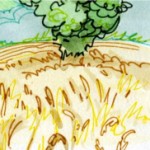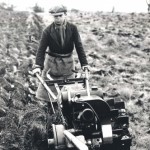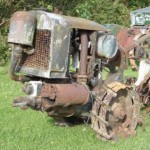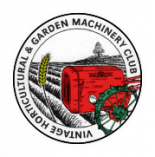Home › Forums › The Machinery Forums › Ride-on machines › can anyone identify this?
- This topic has 19 replies, 8 voices, and was last updated 6 years, 8 months ago by
 charlie.
charlie.
-
AuthorPosts
-
March 24, 2019 at 4:18 pm #30765
andyfrost
ParticipantI also looked at it at Stanfield , for me the jury is still out deciding whether it’s an original production machine , a prototype , or something that has been very well “home engineered”
Personally , I’m leaning toward the latter two of my thoughts , the hydraulic pump , and certainly the pipe work , hardly seem man enough for the machine , I just couldn’t imagine pipe of that diameter permitting enough flow , and this coupled to a very small pump , with no form of cooling the oil.
I , stand to be corrected over this , and really hope some concrete news turns up.Andy.
March 24, 2019 at 7:09 pm #30766 vhgmcbuddyMember
vhgmcbuddyMemberAndy, I quite agree with your reasoning re the hoses, etc….
Internet research reveals the following –
ILO engines/moteurs
Engine manufacturer ILO Motorenwerke was a major manufacturer of 2 stroke engines from 1911 until its decline in 1990’s. The company was founded by Heinrich Christiansen to produce 2 stroke engines at Altona, for many diverse uses. In 1923 to 1925 they also produced a range of motorcycles. In 1959 they where purchased by Rockwell international industries, who produced a range of snow mobiles, then later in 1977 they where acquired by machine giant Tecumseh. Under the Tecumseh brand they continued to expand production to supply engines for lawn mowers, compressors and agricultural items until the mid 1990’s. During there production history ILO produced, trains, all manor of engines but principally 2 stroke, (in fact in 1954 they where the largest producer of 2 stroke engines in West Germany with 184 000 units sold and over 1500 employees). Energic used ILO engines in many motoculteurs, motobinuses and motofaucheuse machines of there day. And to there credit, with the strength and quality of these engines, many Energic machines survive and are in daily use throughout France today.The hydraulic hub mounted motors intrigued me, as clearly they were commercially manufactured; however no matter how hard I stared at them, I could not see any maker’s mark, etc…
Attached is a photograph of the engine maker’s plate, for info.
One line I have looked at using the Internet, is the fact that Coventry Climax, Massey Ferguson, and Warwick University (Motor Research Facility) are all within spitting distance of each other. Just a thought.
March 25, 2019 at 4:39 pm #30772 trusty220Keymaster
trusty220KeymasterOne thing that I picked up back in the Nineties was regarding the JLO name. One of the reps working for IPU (who imported Dori mowers from France) used to say that the name stemmed from Esperanto- it was supposed to be a common Europe-wide language to bind the countries together with one language- and it translated into English as, “A Good Tool”.
Esperanto never really got off the ground and very few people these days have even heard of it; another great idea that came out of Brussels!
March 25, 2019 at 6:20 pm #30773 alanParticipant
alanParticipantI haven’t seen the machine in question in the tinwork so can only go by the information and photos posted.
At first glance I’d say it was homemade, or at least not of mass-production, but questionable past machines which turned out not to be homemade now make me look a bit harder!
I have found a photo and also traced it to some information on a German museum website. The photo show an ILO parade in 1950 at a Rosenfest (Rose Festival) where machines that used ILO engines were driven through the parade. The names of the manufacturers are on each machine and adorned with roses. The interesting bit is that the ILO float is being pulled by a four wheeled, possibly four wheel driven tractor with round fenders, I’m guessing this is powered by an ILO engine?
On the front of the tractor is a rose-surrounded sign saying ‘Willie Schlepper’, the schlepper translating as Tug. I cannot find a manufacturer of machines by the name of Willie, but perhaps it was the tugs nickname? Any ideas?
Questions is, are there more tugs of differing designs? And has this got anything to do with the mystery machine this forum post relates to?
I’d probably be looking to see if the other components on the machine are of German origin, and in particular those wheel hubs. I haven’t seen any similar on the internet yet.
The German Pinnerberg Museum Website has some more pictures of the parade:
https://pinnebergmuseum.de/geschichte-der-jlo-motorenwerke/March 26, 2019 at 7:43 am #30776 charlieKeymaster
charlieKeymasterIf not already featured this would be a good one for the main stream tractor magazines to see if anyone can come up with more information. I wonder if Nick Baldwin has any information from his A-Z of tractors series?
-
AuthorPosts
- You must be logged in to reply to this topic.






